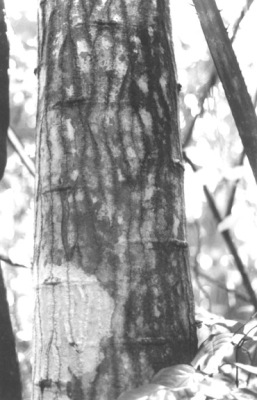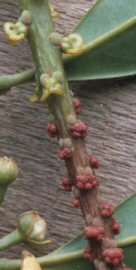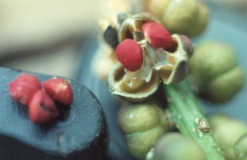Sapium glandulosum (L.) Morong
Euphorbiaceae YOS, YOS LECHOSO
Tree: Common evergreen or briefly deciduous canopy tree (15-20 m). Notable for its thin crown and prominently fissured bole, this species of Yos (one of two) is adapted to the secondary forest, where light levels are high and soils are droughty. Yos plays an important role in the reclamation of storm-ravaged land by the forest and it is a source of plentiful ariled seeds for local avifauna.
 Description: Yos trunks (50 cm) are commonly cylindrical though not usually very straight. The bark is boldly patterned by dark, deep fissures that meander vertically up the bole and that cut its lighter gray surface into narrow strips. Often, the trunk is further textured by prominent branch scars manifest as raised and horizontally-stretched knobs that are periodically spaced along its length. If the bark, twigs or leaves of this species are cut or broken, a thick, white, latex-containing sap is exuded. Branches and twigs are fat and relatively few in number. This, combined with a spare covering of foliage, produces a very open and airy crown. The leaves (15 cm by 3.5 cm) are simple, alternate, finely serrate, and long petioled (2 cm). They appear to encircle the twigs and branches that bear them (and are thus said to be arranged in whorls – a relatively unusual pattern that serves as a reliable identifying characteristic). Blade shape is elliptical and their short, stubby drip-tips are thickened and partially folded. Two pointed glands protrude from the petiole near the base of the blade. Foliage is completely shed in March, and then renewed almost immediately as the tree enters the growth portion of its annual cycle.
Description: Yos trunks (50 cm) are commonly cylindrical though not usually very straight. The bark is boldly patterned by dark, deep fissures that meander vertically up the bole and that cut its lighter gray surface into narrow strips. Often, the trunk is further textured by prominent branch scars manifest as raised and horizontally-stretched knobs that are periodically spaced along its length. If the bark, twigs or leaves of this species are cut or broken, a thick, white, latex-containing sap is exuded. Branches and twigs are fat and relatively few in number. This, combined with a spare covering of foliage, produces a very open and airy crown. The leaves (15 cm by 3.5 cm) are simple, alternate, finely serrate, and long petioled (2 cm). They appear to encircle the twigs and branches that bear them (and are thus said to be arranged in whorls – a relatively unusual pattern that serves as a reliable identifying characteristic). Blade shape is elliptical and their short, stubby drip-tips are thickened and partially folded. Two pointed glands protrude from the petiole near the base of the blade. Foliage is completely shed in March, and then renewed almost immediately as the tree enters the growth portion of its annual cycle.  Yos flowers are borne on reddish-green terminal spikes (15 cm), with each inflorescence containing the separate flowers of both sexes. Male blossoms, more numerous and smaller, are composed of discreet clumps of red stamens and they are arranged along the distal three quarters of the spike. Female blossoms – green globular (4 mm) structures topped by three-part, divided pistils – occupy the spike’s proximal end. Flowers appear in late March and last until early June. The fruits are capsules (1.5 cm) that develop from the ovaries of the female flowers. Numbering three or four per spike, each capsule dries and opens into three sections. An equal number of red-ariled seeds, suspended at the ends of a small stalks found inside the capsule, are then revealed. The bright red arils – in full view of wildlife – are spongy and contain a sweet-smelling, milky liquid. Fruiting occurs from late July to early September. Seeds germinate soon (within a week or two) after coming into contact with the moist forest floor.
Yos flowers are borne on reddish-green terminal spikes (15 cm), with each inflorescence containing the separate flowers of both sexes. Male blossoms, more numerous and smaller, are composed of discreet clumps of red stamens and they are arranged along the distal three quarters of the spike. Female blossoms – green globular (4 mm) structures topped by three-part, divided pistils – occupy the spike’s proximal end. Flowers appear in late March and last until early June. The fruits are capsules (1.5 cm) that develop from the ovaries of the female flowers. Numbering three or four per spike, each capsule dries and opens into three sections. An equal number of red-ariled seeds, suspended at the ends of a small stalks found inside the capsule, are then revealed. The bright red arils – in full view of wildlife – are spongy and contain a sweet-smelling, milky liquid. Fruiting occurs from late July to early September. Seeds germinate soon (within a week or two) after coming into contact with the moist forest floor.
Natural History: Yos flowers are pollinated by bees and other flying insects. After this has occurred, the male end of the flower spike dies and drops off, leaving only the female flowers to develop into fruiting capsules. Once mature and open, the ariled seeds become an obvious and easily detectable food source for animals – especially birds. Pale-vented Pigeons have been observed harvesting these seeds in large flocks.  Presumably, the seed is regurgitated or expelled in droppings after consumption and thus dispersed a good distance away from the parent tree. Apparently, white-faced monkeys harvest Sapium fruit as well (Croat, 1978).
Presumably, the seed is regurgitated or expelled in droppings after consumption and thus dispersed a good distance away from the parent tree. Apparently, white-faced monkeys harvest Sapium fruit as well (Croat, 1978).
Yos trees and saplings are sturdy and resistant to drought and excessive sunlight and are thus good pioneer plants. They frequently are among the first to invade clearings caused by tree-falls, landslides, or human intervention. They are also good competitors on steep slopes where soils are thin and xeric conditions are prevalent. Saplings one meter tall have been observed in storm-damaged sites after only two years of regeneration.
Another member of the Sapium genus (not present in Manuel Antonio), S. sebiferum, is the Chinese tallow tree and the greasy material surrounding its seeds is used in making soap and candles. (Radcliffe-Smith, 1978).
Interestingly, Sapium-type flower spikes, containing spatially separate male and female flowers, are also common in the Euphorb genus Croton (see C. schniedeanus).
Uses: Yos has potential for use in reforestation programs, where poor, droughty soils in sunny locations are to be reclaimed. Well adapted to such harsh conditions, this secondary species is capable of improving and stabilizing the environment so that other, more sensitive but longer lived forest trees can gain a foothold. Allen (1956) says that the wood is pale-yellow, light, and not used.
Distribution: This species of Sapium can be found along trail sides and amid secondary growth. Often, it can be seen growing on dry slopes and hillsides. It ranges from Mexico to northern South America and the Antilles.
